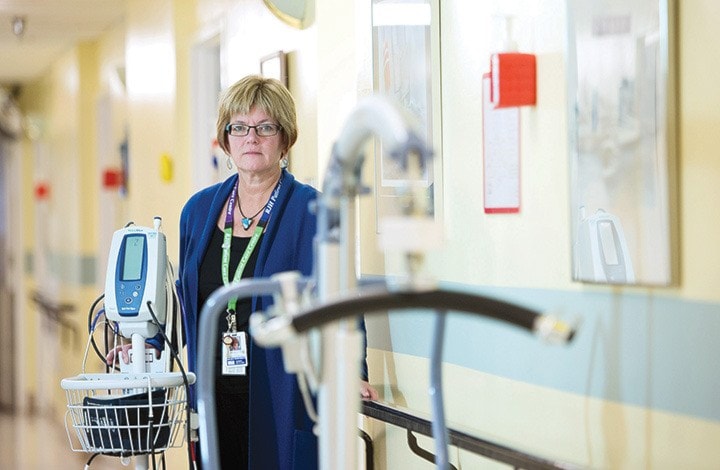Part 2 in a series
Kelley Charters starts her shift at 7:30 a.m. If she’s lucky, none of her registered nurse co-workers will call in sick, otherwise she could be asked to work more than her scheduled 12-hour shift, a common occurrence for frontline health-care staff.
On arrival, Charters huddles with night shift acute care nurses to get information on patients on the ward, which allows her to prioritize the four or five patients under her watch.
“I look at the patients, learn about their care plan, prioritize them, figure out who needs to get what tests, who needs to be seen first,” said Charters, an RN at Nanaimo Regional Hospital, and shop steward for the B.C. Nurses’ Union.
“I would do a head-to-toe assessment on each patient, check for any pain, get to know the patient and pick up on any changes throughout the day.”
Charters’ said her routine and workload have changed since September 2013, when Island Health implemented a new patient care system called care delivery model redesign (CDMR).
The new model delegates some nursing duties, such as feeding, bathing and toileting of patients to health care aides. The change was made to address a nursing shortage that resulted in spiralling overtime costs and nurses burning out, said CDMR executive leader Rita den Otter.
“When we first started going down this path seven or eight years ago, the issue was to look ahead,” den Otter said. “We had an aging workforce and a bunch of baby boomers retiring. We wanted to find out if we had enough people coming behind (to replace) them.”
Den Otter’s research forecast a looming nurse shortage and also found patient characteristics had changed. Two to three decades ago, most patients were admitted to hospital for surgeries and injuries, such as broken bones, but they tended to be younger and recovered faster.
These days hospitals are seeing a steady increase of elderly people with mobility issues and chronic diseases, and who stay longer and require more attention.
“The patients needs are more complex and it is better met with a team of health care providers,” she said. “Nurses were the single provider of patient needs, which made sense 20, 30 years ago when the needs weren’t as complex.”
Nanaimo General was the first major hospital on Vancouver Island to implement CDMR. Changes are set to roll out at Victoria General and Royal Jubilee starting April 23.
Charters said a few casual nurses at Nanaimo General have refused to work in departments implementing CDMR due to stress, a toxic work environment and poorer patient care.
“Patients are definitely seeing a delay in treatment. Medication is being given to patients late, regularly,” Charters said. “I can’t get to know 10 patients in 12 hours.”
Den Otter refutes Charters’ claim, and said CDMR is intended to ease RN workloads.
“Nurses will never look after 10 patients on their own – they will always have a team of care aides, licensed practical nurses and other health care providers,” den Otter said.
“I don’t know how it would ever be 10 unless people weren’t able to come in and the nurses are working short, and for some reason we can’t bring more staff in.”
Charters said while care aides are valued for their work, they don’t have the same emergency training or education to notice slight changes in conditions of patients in acute care.
“When a nurse takes someone to the washroom or even washes them, we are not just doing that. We are also assessing their skin, we can see changes in a patient’s vital system, changes in breathing,” she said. “Under the new model we are being forced to rely on someone who does not have the training to make those assessments.”
Sabrina Wong, an associate professor in the school of nursing at the University of B.C., echoed Charters’ assessment.
“I absolutely agree that care aides may not be able to assess subtle changes that can be found when bathing and feeding a patient,” Wong said. “Higher acuity patients need more nursing rather than less.”
In the meantime, Charters will work with CDMR, but hopes Island Health will abandon or make drastic changes to it. “It seems like they steamrolled it through.
“We need to stop and take a breath. We want to sit down and work with them (Island Health). Overtime is high because (casual nurses) don’t want to come to work. Nurses know how to save money in different ways. They just need to speak to us.”
editor@vicnews.com
Part 1: New Vancouver Island model will hurt patient care, BCNU says
